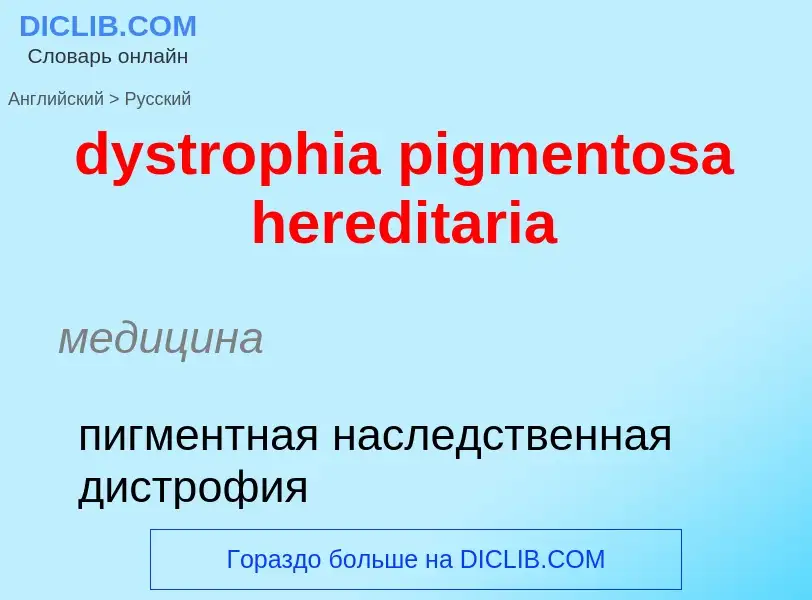Vertaling en analyse van woorden door kunstmatige intelligentie ChatGPT
Op deze pagina kunt u een gedetailleerde analyse krijgen van een woord of zin, geproduceerd met behulp van de beste kunstmatige intelligentietechnologie tot nu toe:
- hoe het woord wordt gebruikt
- gebruiksfrequentie
- het wordt vaker gebruikt in mondelinge of schriftelijke toespraken
- opties voor woordvertaling
- Gebruiksvoorbeelden (meerdere zinnen met vertaling)
- etymologie
dystrophia pigmentosa hereditaria - vertaling naar russisch
медицина
пигментная наследственная дистрофия
медицина
пигментная дегенерация сетчатки
медицина
пигментная дегенерация сетчатки
Definitie
Wikipedia

Retinitis pigmentosa (RP) is a genetic disorder of the eyes that causes loss of vision. Symptoms include trouble seeing at night and decreasing peripheral vision (side and upper or lower visual field). As peripheral vision worsens, people may experience "tunnel vision". Complete blindness is uncommon. Onset of symptoms is generally gradual and often begins in childhood.
Retinitis pigmentosa is generally inherited from one or both parents or rarely it can be caused by a miscoding during DNA division. It is caused by genetic miscoding of proteins in one of more than 300 genes involved. The underlying mechanism involves the progressive loss of rod photoreceptor cells that line the retina of the eyeball. The rod cells secrete a neuroprotective substance (Rod-derived cone viability factor, RdCVF) that protects the cone cells from apoptosis (cell death). However, when the rod cells die, this substance is no longer provided. This is generally followed by the loss of cone photoreceptor cells. Diagnosis is by eye examination of the retina finding dark pigment deposits caused by the rupture of the underlying retinal pigmented epithelial cells, given that these cells contain a pigment known as melanin. Other supportive testing may include the electroretinogram (ERG), visual field testing (VFT), ocular coherence tomography (OCT) and DNA testing to determine the gene responsible for a person's particular type of RP (now called Inherited Retinal Dystrophy (IRD).
There is currently no cure for retinitis pigmentosa. Efforts to manage the problem may include the use of low vision aids, portable lighting, or orientation and mobility training. Vitamin A palmitate supplements may be useful to slow worsening. A visual prosthesis may be an option in certain people with severe disease.
Currently there is only one FDA-approved gene therapy that is commercially available to RP patients with Leber congenital amaurosis type 2. It replaces the miscoded RPE65 protein that is produced within the retinal pigmented epithelium. It has been found to effectively work in about 50% of the patients who receive the therapy. The earlier the child receives the RPE65 therapy the better the chances for a positive outcome. There are many other therapies being researched at this time with the goal of being approved in the next few years.
It is estimated to affect 1 in 4,000 people.


![cone]] photoreceptors. The elongated rods are colored yellow and orange, while the shorter cones are colored red. cone]] photoreceptors. The elongated rods are colored yellow and orange, while the shorter cones are colored red.](https://commons.wikimedia.org/wiki/Special:FilePath/ScanEMphoto.jpg?width=200)
